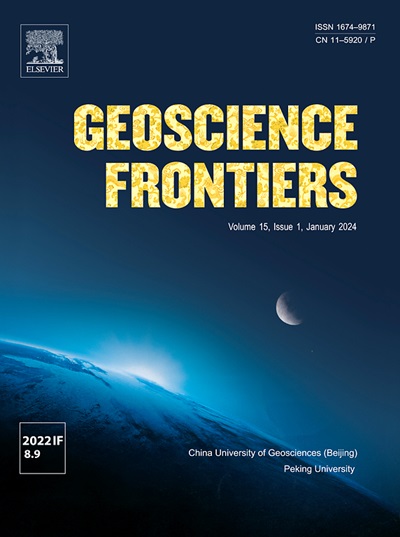印度南部中太古代库格地块早白垩世柱状玄武岩:一个潜在的羽状裂陷事件还是一个局部岩浆现象?
IF 8.9
1区 地球科学
Q1 GEOSCIENCES, MULTIDISCIPLINARY
引用次数: 0
摘要
地幔柱在东冈瓦纳地壳碎片裂陷的最后阶段的作用仍然是模棱两可的,迄今为止只有来自印度半岛南部的有限证据。本文首次报道了印度南部麻粒岩地(SGT)中太古代古格地块的一套柱状玄武岩,并通过野外、岩石学、地球化学和同位素年代学研究对这些岩石进行了表征。玄武岩呈斑状结构,辉石和斜长石斑晶嵌于细地质体中。地球化学资料显示,斑流玄武岩与羽状岩浆活动具有亲和性。锆石U-Pb数据加权平均年龄为137 Ma,对应于早白垩世的Valanginian时代。我们提出了所研究岩石的可能的地球化学亲和性,为研究与东冈瓦纳裂谷最后阶段有关的岩浆作用提供了新的见解。本文章由计算机程序翻译,如有差异,请以英文原文为准。

Early Cretaceous columnar basalts from the Mesoarchean Coorg Block, Southern India: A potential plume-influenced rifting event or a localized magmatic phenomenon?
The role of mantle plume in the final stages of rifting of the East Gondwana crustal fragments remains equivocal with only limited evidence so far reported from the southern part of Peninsular India. Here, we report for the first time a suite of columnar basalts from the Mesoarchean Coorg Block in the Southern Granulite Terrain (SGT) of India and characterize these rocks through field, petrological, geochemical, and isotope geochronological studies. The basalts show porphyritic texture with phenocrysts of pyroxene and plagioclase embedded in fine groundmass. Geochemical data reveal tholeiitic flood basalt affinity with affinities of plume-related magmatism. The zircon U-Pb data of the rocks yield a weighted mean age of 137 Ma, thus corresponding to the Valanginian Age of the Early Cretaceous Period. We suggest the possible geochemical affinity of the studied rocks Kerguelen plume basalts which provide new insights into magmatism associated with the final stages of East Gondwana rifting.
求助全文
通过发布文献求助,成功后即可免费获取论文全文。
去求助
来源期刊

Geoscience frontiers
Earth and Planetary Sciences-General Earth and Planetary Sciences
CiteScore
17.80
自引率
3.40%
发文量
147
审稿时长
35 days
期刊介绍:
Geoscience Frontiers (GSF) is the Journal of China University of Geosciences (Beijing) and Peking University. It publishes peer-reviewed research articles and reviews in interdisciplinary fields of Earth and Planetary Sciences. GSF covers various research areas including petrology and geochemistry, lithospheric architecture and mantle dynamics, global tectonics, economic geology and fuel exploration, geophysics, stratigraphy and paleontology, environmental and engineering geology, astrogeology, and the nexus of resources-energy-emissions-climate under Sustainable Development Goals. The journal aims to bridge innovative, provocative, and challenging concepts and models in these fields, providing insights on correlations and evolution.
 求助内容:
求助内容: 应助结果提醒方式:
应助结果提醒方式:


